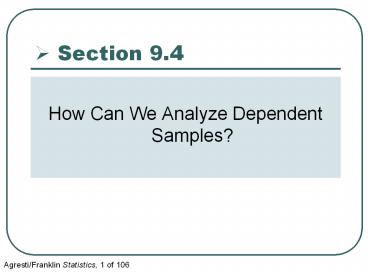How Can We Analyze Dependent Samples? PowerPoint PPT Presentation
Title: How Can We Analyze Dependent Samples?
1
Section 9.4
- How Can We Analyze Dependent Samples?
2
Dependent Samples
- Each observation in one sample has a matched
observation in the other sample - The observations are called matched pairs
3
Example Matched Pairs Design for Cell Phones
and Driving Study
- The cell phone analysis presented earlier in this
text used independent samples - One group used cell phones
- A separate control group did not use cell phones
4
Example Matched Pairs Design for Cell Phones
and Driving Study
- An alternative design used the same subjects for
both groups - Reaction times are measured when subjects
performed the driving task without using cell
phones and then again while using cell phones
5
Example Matched Pairs Design for Cell Phones
and Driving Study
- Data
6
Example Matched Pairs Design for Cell Phones
and Driving Study
- Benefits of using dependent samples (matched
pairs) - Many sources of potential bias are controlled so
we can make a more accurate comparison - Using matched pairs keeps many other factors
fixed that could affect the analysis - Often this results in the benefit of smaller
standard errors
7
Example Matched Pairs Design for Cell Phones
and Driving Study
- To Compare Means with Matched Pairs, Use Paired
Differences - For each matched pair, construct a difference
score - d (reaction time using cell phone) (reaction
time without cell phone) - Calculate the sample mean of these differences
xd
8
For Dependent Samples (Matched Pairs)
- Mean of Differences
- Difference of Means
9
For Dependent Samples (Matched Pairs)
- The difference (x1 x2) between the means of the
two samples equals the mean xd of the difference
scores for the matched pairs - The difference (µ1 µ2) between the population
means is identical to the parameter µd that is
the population mean of the difference scores
10
For Dependent Samples (Matched Pairs)
- Let n denote the number of observations in each
sample - This equals the number of difference scores
- The 95 CI for the population mean difference is
11
For Dependent Samples (Matched Pairs)
- To test the hypothesis H0 µ1 µ2 of equal
means, we can conduct the single-sample test of
H0 µd 0 with the difference scores - The test statistic is
12
For Dependent Samples (Matched Pairs)
- These paired-difference inferences are special
cases of single-sample inferences about a
population mean so they make the same assumptions
13
Paired-difference Inferences
- Assumptions
- The sample of difference scores is a random
sample from a population of such difference
scores - The difference scores have a population
distribution that is approximately normal - This is mainly important for small samples (less
than about 30) and for one-sided inferences
14
Paired-difference Inferences
- Confidence intervals and two-sided tests are
robust They work quite well even if the
normality assumption is violated - One-sided tests do not work well when the sample
size is small and the distribution of differences
is highly skewed
15
Example Matched Pairs Analysis for Cell Phones
and Driving Study
- Boxplot of the 32 difference scores
16
Example Matched Pairs Analysis for Cell Phones
and Driving Study
- The box plot shows skew to the right for the
difference scores - Two-sided inference is robust to violations of
the assumption of normality - The box plot does not show any severe outliers
17
Example Matched Pairs Analysis for Cell Phones
and Driving Study
18
Example Matched Pairs Analysis for Cell Phones
and Driving Study
- Significance test
- H0 µd 0 (and hence equal population means for
the two conditions) - Ha µd ? 0
- Test statistic
19
Example Matched Pairs Analysis for Cell Phones
and Driving Study
- The P-value displayed in the output is 0.000
- There is extremely strong evidence that the
population mean reaction times are different
20
Example Matched Pairs Analysis for Cell Phones
and Driving Study
- 95 CI for µd (µ1 - µ2)
21
Example Matched Pairs Analysis for Cell Phones
and Driving Study
- We infer that the population mean when using cell
phones is between about 32 and 70 milliseconds
higher than when not using cell phones - The confidence interval is more informative than
the significance test, since it predicts just how
large the difference must be
22
Section 9.5
- How Can We Adjust for Effects of Other Variables?
23
A Practically Significant Difference
- When we find a practically significant difference
between two groups, can we identify a reason for
the difference? - Warning An association may be due to a lurking
variable not measured in the study
24
Example Is TV Watching Associated with
Aggressive Behavior?
- In a previous example, we saw that teenagers who
watch more TV have a tendency later in life to
commit more aggressive acts - Could there be a lurking variable that influences
this association?
25
Control Variable
- A control variable is a variable that is held
constant in a multivariate analysis (more than
two variables)
26
Can An Association Be Explained by a Third
Variable?
- Treat the third variable as a control variable
- Conduct the ordinary bivariate analysis while
holding that control variable constant at fixed
values - Whatever association occurs cannot be due to
effect of the control variable

